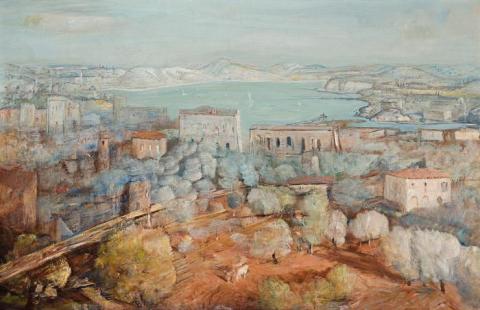AFTERNOON IN TUSCANY (TUSCAN JOURNEY NO.2), c.1953
Lloyd Rees
oil on canvas
76.0 x 116.5 cm
signed lower right: L. REES
Bonython Art Gallery, Adelaide
Acquired from the above in 1962
Private collection, Adelaide
Lloyd Rees, Bonython Art Gallery, Adelaide, 20 – 31 August 1962, cat. 16
In 1953, Lloyd Rees travelled through Italy, France, Spain, and Britain. In Italy he spent a month in the old medieval town of San Gimignano in Tuscany. Writing, in 1977, to the owner of Afternoon in Tuscany, Rees said, 'I clearly remember as it was probably my most complete summing up of the Tuscan Landscape. Based on 1953 experiences & drawings etc in Tuscany it was worked on over a period of years & possibly after our 1939 [sic.] visit to San Gimignano; as a good deal of work at the Bonython exhibition was based on that visit.'1 A much admired painting from the 1953 visit, San Gimignano, 1953, is in the collection of the Art Gallery of South Australia. Like this painting, it provides a view of panoramic splendour, of a countryside long shaped by the hand of man with its buildings, roads, terraced curve of the landscape and the gentle rhythm of the hills reaching seamlessly into the sky. Afternoon in Tuscany is similar in style, atmosphere, breadth and detail. There is that same freedom of handling of paint, the mood of afternoon is palpable, not even disturbed by the white oxen tilling the ochre field, and its panoramic beauty is beguiling. There is, however, one big difference. While San Gimignano is clearly based on a specific place in Tuscany, often visited and much enjoyed by Rees and his wife, Afternoon in Tuscany is what might be called a composite image, characterised by its alternative title, Tuscan Journey No 2. Rather than being of an exact location, it provides a summation of his responses to Tuscany, a recollection and celebration of things Tuscan through its countryside. Here is the evidence of one of Europe's greatest civilisations set within a landscape of awesome beauty, created through Rees' imagination and aided by the sensuous quality of his paint.
This is not the first of such paintings, his old artist-friend Douglas Dundas pointing out that Rees' 1951 Commonwealth Jubilee Art Prize of Sydney 'was not a factual representation but something that had grown out of years of experience and affection for his adopted city.'2 He continued, 'As in so many of his works, the character of the subject has been so thoroughly absorbed that it serves only as a point of departure for a work of imagination.' Many works similar in approach followed, amongst them some of his best. They include the five paintings of A Tribute to France, of which Country I (Beziers), 1969, is in the collection of the Art Gallery of New South Wales, and the majestic Australian trilogy, Song to Creation.
1. Rees, L, Letter to the Vendor, 27 May 1977. The artist visited San Gimignano in 1959, not 1939. Earlier visits to Italy were made in 1923 and 1953
2. Dundas, D, 'Lloyd Rees', Art and Australia, vol. 7, no. 2, September 1969, p. 130
DAVID THOMAS
